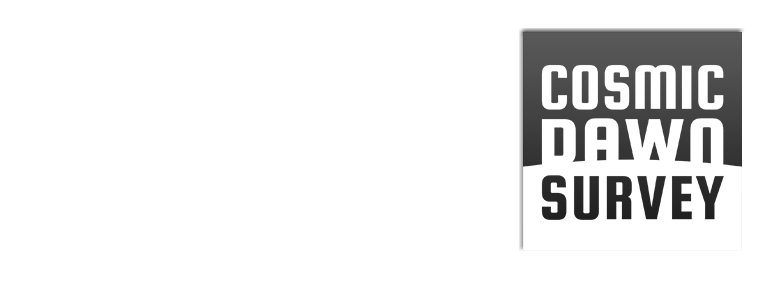Overview
The Cosmic DAWN Survey is a 59 deg² multi-wavelength imaging survey designed to complement Euclid’s deep-field observations. By integrating matched-depth data across the UV to near-infrared (NIR) spectrum, DAWN aims to produce self-consistent photometric catalogs, accurate photometric redshifts, and detailed galaxy property measurements for sources up to z ≈ 10.
Scientific Objectives
The survey’s primary goals include:
-
Characterizing the high-redshift galaxy population (z > 4): DAWN provides deep, contiguous imaging essential for measuring the galaxy stellar mass function (SMF) and UV luminosity function (UVLF) over large cosmic volumes.
-
Constraining cosmic reionization and large-scale structure evolution: By identifying rare overdense regions and probing cosmic voids, DAWN enhances our understanding of early large-scale structure formation.
-
Refining photometric redshift estimates for Euclid: DAWN’s consistent processing of multi-band data supports photometric calibration and bias correction for the Euclid Wide Survey.
Survey Fields and Observations
The survey spans three Euclid Deep Fields (EDFs) and six Euclid Auxiliary Fields (EAFs), chosen for their extensive legacy datasets. DAWN’s observations integrate:
-
Euclid VIS and NISP imaging in single broadband visible (IE) and three NIR bands (YE, JE, HE).
-
Spitzer/IRAC imaging at 3.6 and 4.5 µm for rest-frame optical coverage at high redshifts.
-
Optical and UV data from CFHT/MegaCam (u-band), Subaru/HSC (grizy bands), and future Rubin Observatory deep drilling fields.
Data Depths and Coverage
The expected 5σ limiting magnitudes (AB) for DAWN imaging are:
-
Euclid NIR bands: 25.8–26.5 (extended sources)
-
Spitzer IRAC: 24.7–25.3
-
HSC grizy: 26.5–28.5
-
MegaCam u-band: 26.4–27.7
The large field-of-view enables statistical studies across multiple environments, mitigating cosmic variance effects inherent in smaller deep-field surveys like CANDELS.
Spectroscopic Calibration
DAWN integrates extensive spectroscopic datasets for redshift calibration, including:
-
Keck/DEIMOS spectroscopy for Lyman-break galaxies and Ly-α emitters.
-
TESLA survey on HET/VIRUS targeting Ly-α emission at z ≈ 2–3.5.
-
Archival spectroscopic databases from the COSMOS, GOODS-N, SXDS, and CDFS fields.
Expected Impact
With a survey volume exceeding 3.8 Gpc³ at z < 7, DAWN is expected to:
-
Provide robust constraints on the high-redshift SMF and UVLF for M⋆ > 10¹¹ M☉ and MUV < -24 at z ≈ 8–10.
-
Enable the first direct measurements of galaxy clustering and bias at z > 4 over tens of square degrees.
-
Offer a foundation for future high-redshift studies with JWST, Rubin, and Euclid.
Data Release and Timeline
The first DAWN data release (Euclid Collaboration: Zalesky et al. 2024) presents photometric catalogs from EDF-N and EDF-F, with subsequent releases incorporating EDF-S and all EAFs. The final dataset, expected post-2030, will serve as a legacy resource for extragalactic studies in the Euclid Deep and Auxiliary fields.
For further details, see Euclid Collaboration: McPartland et al. (2025).








